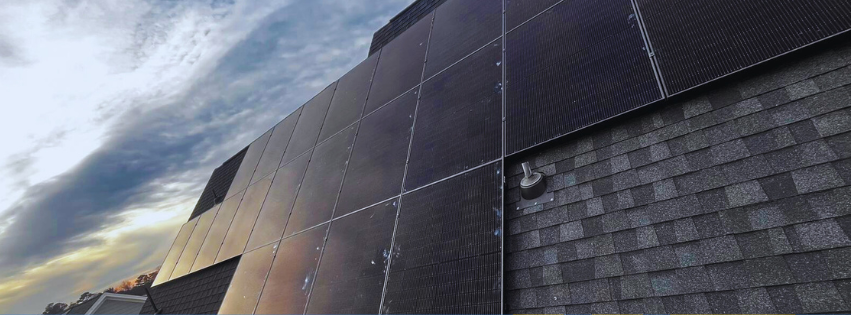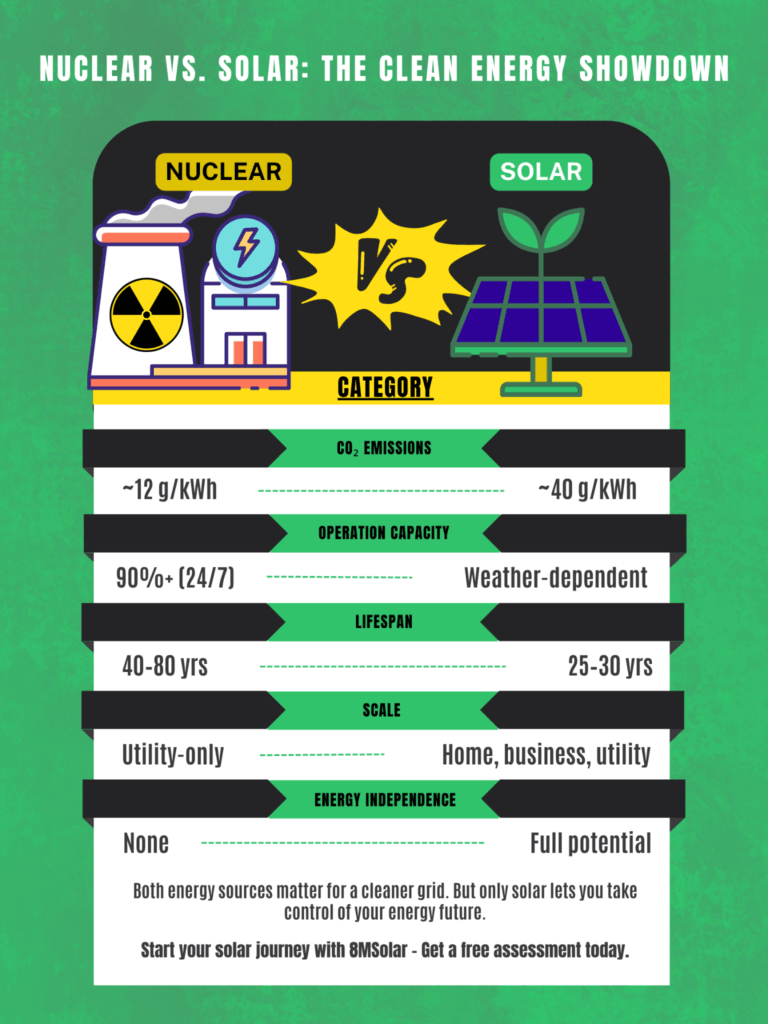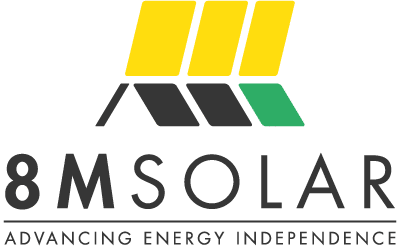The world is at a crossroads. Climate change demands urgent action, and the energy sector stands at the center of the solution. As fossil fuels continue to contribute to rising global temperatures, the search for clean energy sources has never been more critical. Two technologies consistently emerge in these discussions: nuclear energy and solar power. Both promise to reduce carbon emissions, but they take different approaches to generating electricity.
For homeowners, businesses, and communities across North Carolina, understanding these energy sources matters. While nuclear energy operates at the utility scale, powering entire regions, solar energy offers something nuclear cannot—the ability for individual homeowners to take control of their energy. This article explores both technologies honestly, examining their strengths, limitations, and roles in our energy landscape. Whether you’re considering solar panels for your home or want to understand the broader energy debate, knowing how these technologies compare helps you make informed decisions about your energy future.
Understanding Nuclear Energy
Nuclear energy generates electricity through a process called nuclear fission. Inside a nuclear reactor, atoms of uranium-235 are split apart, releasing enormous amounts of heat energy. This heat boils water to create steam, which spins turbines connected to generators, producing electricity. It’s the same basic principle as coal or natural gas plants, but instead of burning fuel, nuclear plants split atoms.
The scale of nuclear energy is staggering. A single uranium fuel pellet the size of a fingertip contains as much energy as 17,000 cubic feet of natural gas, 1,780 pounds of coal, or 149 gallons of oil. This energy density allows nuclear plants to generate massive amounts of electricity from small amounts of fuel.
Nuclear energy provides about 20% of electricity in the United States, operating 93 commercial reactors across 28 states. These plants run continuously, providing what’s called “baseload power”—the minimum amount of electricity the grid needs at any given time. Unlike solar or wind, nuclear plants don’t depend on weather conditions and can operate at full capacity around the clock.
Nuclear technology exists exclusively at the utility scale. There are no residential nuclear reactors, and there never will be. The infrastructure, safety requirements, and regulatory oversight required make nuclear power a solution only for large-scale energy generation managed by utilities and governments.
Pros of Nuclear Energy
Nuclear energy delivers several advantages that make it a significant part of the clean energy conversation.
The energy output from nuclear plants is extraordinary. A typical nuclear power plant generates around 1,000 megawatts of electricity, enough to power roughly 750,000 homes. That same output would require approximately 3 million solar panels covering about 7,500 acres of land. This energy density means nuclear plants can produce vast amounts of electricity while occupying relatively small footprints.
Reliability sets nuclear apart from many other energy sources. Nuclear plants operate at over 90% capacity factor, meaning they produce electricity at or near their maximum output more than 90% of the time. They run continuously, day and night, regardless of weather conditions. This consistency makes nuclear ideal for providing baseload power—the steady, dependable electricity supply that keeps the grid stable.
From a carbon perspective, nuclear energy performs well. During operation, nuclear plants produce virtually no greenhouse gas emissions. Over their full lifecycle, nuclear energy produces about 12 grams of CO2 equivalent per kilowatt-hour, comparable to wind power and lower than solar’s 40 grams per kilowatt-hour.
The physical footprint advantage can’t be overstated. While renewable energy sources like wind require vast expanses of land to generate equivalent power, nuclear plants concentrate enormous energy production in compact facilities. This efficiency in land use preserves natural habitats and agricultural land.
Nuclear plants also boast impressive operational lifespans. Most reactors are licensed to operate for 40 years, and many receive extensions to 60 or even 80 years. This longevity means decades of carbon-free electricity from a single facility.
Recent technological advances promise even better performance. Next-generation reactors, including small modular reactors and advanced designs like lead-cooled fast reactors, offer improved safety features, reduced waste production, and greater flexibility in responding to grid demands.
Cons of Nuclear Energy
Despite its advantages, nuclear energy faces challenges that have slowed its adoption and raised serious concerns.
The costs of nuclear power plants are staggering. Modern nuclear facilities cost between $6 billion and $9 billion to construct, with some projects exceeding $30 billion when delays and overruns are factored in. The Vogtle Electric Generating Plant in Georgia, the first new nuclear plant built in the U.S. in decades, came with a price tag exceeding $30 billion—more than double its original estimate.
Construction timelines stretch beyond other energy sources. Building a nuclear plant takes 10 to 15 years from planning to operation, and many projects experience delays. This extended timeline means communities wait years before seeing any electricity or return on investment.
Radioactive waste remains one of nuclear energy’s most persistent problems. Spent nuclear fuel remains hazardous for thousands of years, and the United States still lacks a permanent disposal solution. Currently, nuclear waste sits in temporary storage facilities at plant sites across the country, a stopgap measure that was never intended to be permanent.
Safety concerns, while statistically rare, carry catastrophic potential. The accidents at Three Mile Island, Chernobyl, and Fukushima demonstrated that when things go wrong with nuclear plants, the consequences can be devastating and long-lasting. Modern reactors incorporate numerous safety improvements, but the potential for serious accidents can never be entirely eliminated.
Public perception presents another hurdle. Many communities resist nuclear plants in their areas, driven by safety fears and concerns about property values. This “not in my backyard” sentiment has effectively blocked numerous proposed projects.
Decommissioning costs add billions more to the lifetime expense of nuclear plants. Safely dismantling a nuclear facility and managing its radioactive components costs between $300 million and $1 billion per plant.
Most importantly for homeowners and businesses, nuclear energy offers no path to individual energy independence. You can’t install a nuclear reactor on your property. You cannot reduce your electricity bills with nuclear power. You remain entirely dependent on utility companies and their rate structures. Nuclear energy, for all its advantages at the grid level, provides no direct benefit to individual consumers seeking control over their energy costs.

Understanding Solar Energy
Solar energy harnesses the power of the sun through photovoltaic technology. Solar panels contain semiconductor materials that generate an electrical current when sunlight strikes them. This phenomenon, called the photovoltaic effect, converts light energy directly into electricity without moving parts, combustion, or emissions.
The panels on a rooftop or solar farm consist of many individual solar cells wired together. When photons from sunlight hit these cells, they knock electrons loose from atoms, creating a flow of electricity. An inverter then converts this direct current (DC) electricity into alternating current (AC) electricity that can power homes, businesses, or feed into the electrical grid.
Solar adoption has exploded in recent years. In 2023, the United States installed over 32 gigawatts of solar capacity, enough to power approximately 6 million homes. Solar now represents one of the fastest-growing energy sources in the country, with installations spanning from individual homes to massive utility-scale solar farms.
Unlike nuclear energy, solar works at every scale. A homeowner in North Carolina can install panels on their roof to offset their electricity bills. Utilities can build solar farms to supply power to thousands of homes. This scalability makes solar accessible in ways nuclear energy can never be.
Pros of Solar Energy
Solar energy delivers powerful benefits that have driven its rapid adoption across the country.
The renewable nature of solar stands unmatched. As long as the sun rises—which scientists predict will continue for another 5 billion years—solar energy remains available. Unlike fossil fuels or even uranium, sunlight cannot be depleted. Every location on Earth receives solar energy, making it a universal resource.
For homeowners and businesses, solar dramatically reduces electricity bills. A residential solar system can offset 50% to 100% of electricity costs, depending on system size and energy usage. Through net metering programs, homeowners can even sell excess electricity back to the grid, turning their electric meter backward and further reducing costs. Over the 25 to 30-year lifespan of solar panels, these savings can amount to tens of thousands of dollars.
The accessibility of solar energy sets it apart from nuclear power. Homeowners can install solar panels on their roofs in a matter of days or weeks, not years. Businesses can add solar to their facilities without waiting for utility approval or government permits beyond standard electrical work. This direct access to energy production empowers individuals to control their energy future.
Maintenance requirements remain minimal. Solar panels have no moving parts, so wear and tear stays low. Cleaning the panels a few times per year and occasional inspections suffice. Most quality manufacturers offer warranties of 25 years or more, and panels often continue producing electricity well beyond that timeframe. After the initial investment, ongoing costs stay low.
The cost of solar has plummeted. In the past decade, solar panel prices have dropped by more than 70%, making solar accessible to a much broader range of homeowners and businesses. This trend continues as manufacturing scales up and technology improves. Combined with state incentives available in many areas, solar installations have never been more affordable.
Battery storage technology has transformed solar’s capabilities. Systems like the Tesla Powerwall, LG batteries, and others allow homeowners to store excess solar energy generated during the day for use at night or during power outages. This pairing of solar with storage creates a resilient energy system that can operate independently of the grid when needed.
Environmental benefits extend beyond zero emissions during operation. Solar installations don’t require mining, drilling, or combustion. They don’t produce hazardous waste. They don’t risk catastrophic accidents. While manufacturing solar panels does have environmental impacts, studies show that panels generate enough clean energy to offset their production impacts within one to four years, then continue producing clean energy for decades more.
Property values increase with solar installations. Studies show that homes with solar panels sell faster and for higher prices than comparable homes without solar. Buyers recognize the value of reduced electricity costs and energy independence.

Cons of Solar Energy
Solar energy, while powerful, comes with limitations that homeowners should understand.
Weather dependency affects solar production. Panels generate the most electricity on sunny days and produce less on cloudy or rainy days. They generate no electricity at night. For regions like North Carolina, seasonal variations mean panels produce more energy in summer months than in winter. However, solar panels continue working even on overcast days, just at reduced capacity.
The initial investment can seem substantial. A residential solar installation costs between $15,000 and $25,000 before incentives. After applying state incentives, costs drop, but the upfront expense still requires planning. Financing options, including solar loans and leases, help make solar more accessible, but homeowners must consider their budget carefully.
Space requirements mean not every property is ideal for solar. Panels need adequate roof space with good sun exposure, or available land for ground-mounted systems. Properties with heavy tree coverage, north-facing roofs, or small roof areas may face challenges in generating enough electricity to meet their needs.
While solar panels alone can reduce electricity bills through net metering, achieving true energy independence requires battery backup. Battery systems can add $10,000 to $20,000 to the total project cost. However, batteries provide value beyond just storage—they create backup power during grid outages and allow homeowners to avoid peak electricity rates.
Intermittency without storage means solar-only systems still rely on the grid when the sun isn’t shining. Homeowners remain connected to utility companies, drawing power at night or during extended cloudy periods. This grid connection provides reliability but means you’re not completely independent.
Manufacturing solar panels does have environmental impacts. Production requires energy, raw materials like silicon and metals, and involves some hazardous materials. Transportation and installation add carbon emissions. However, the clean energy generated over a panel’s 30-year lifespan outweighs these initial impacts, offsetting production emissions within the first few years of operation.
Panel efficiency varies by location and season. A solar system in Arizona will generate more electricity than an identical system in cloudy Seattle. Seasonal changes affect production, with longer summer days producing more energy than shorter winter days. Proper system sizing accounts for these variations to guarantee adequate energy production year-round.

Nuclear and Solar: Competitors or Companions?
In energy policy debates, nuclear energy and renewable energy technologies like solar are often viewed as competitors fighting for funding, political support, and market share. This framing misses a crucial reality: these technologies could be better together.
Researchers at the University of Wisconsin-Madison are studying how nuclear and solar can complement each other. Ben Lindley, an assistant professor of engineering physics and nuclear reactor expert, partnered with Mike Wagner, a solar energy expert, to design integrated energy systems that combine next-generation nuclear reactors with concentrating solar power plants.
Their research reveals fascinating possibilities. Nuclear reactors provide steady, reliable baseload power around the clock. Solar plants generate electricity during peak sunlight hours and, when paired with thermal storage systems, can dispatch that energy when demand spikes in the evening. By integrating these systems—sharing components like molten salt thermal storage and power generation equipment—utilities can reduce capital costs while creating more flexible power plants.
The researchers discovered that in markets with high electricity price volatility like California, where solar and wind have created significant price swings between day and night coupled nuclear and thermal storage systems can achieve a 10% improvement in revenue compared to traditional nuclear plants. This finding suggests that as more renewable energy comes online across the country and electricity prices become more volatile, hybrid approaches combining different clean energy sources may become more valuable.
For utilities and grid operators, this research points toward an energy future where nuclear provides consistent baseload power while solar and other renewables add flexible, distributed generation that responds to demand patterns and market conditions. The two technologies serve different but complementary roles in a clean energy grid.
For homeowners and businesses, this broader energy landscape matters because it affects electricity rates, grid reliability, and the value of rooftop solar. As utilities invest in diverse clean energy sources the grid becomes more stable and resilient. Meanwhile, solar panels on homes and businesses contribute to this distributed generation network, reducing strain on the grid during peak demand hours and providing backup power during outages.
The key insight is that we don’t have to choose between nuclear and solar. Large-scale nuclear plants can anchor the grid with reliable baseload power. Utility-scale solar farms can add flexible generation. And residential solar installations empower individual homeowners to participate directly in the clean energy transition while reducing their electricity costs and increasing their energy independence.
Take Control of Your Energy Future
Understanding the landscape of clean energy technologies helps put your energy choices in perspective. Nuclear energy plays an important role in reducing carbon emissions at the utility scale, providing the baseload power our grid requires. It will continue to be part of America’s energy mix for decades to come.
But for homeowners and businesses in North Carolina, solar energy offers something nuclear never can: control over your energy costs and the path to true energy independence. You can install solar panels on your property, generate your own clean electricity, reduce or eliminate your utility bills, and protect yourself against rising electricity rates. You can pair solar with battery storage to keep your home powered during outages. You can take action on climate change while saving money.
At 8MSolar, we’ve helped thousands of homeowners and businesses across North Carolina make the switch to solar. Our expert team handles everything from system design to installation, ensuring you get a solar solution tailored to your needs, property, and energy goals. We use premium equipment, provide transparent pricing, and back our work with industry-leading warranties.
The energy landscape is changing. Utilities are investing in diverse clean energy sources. Technology is advancing rapidly. And homeowners who install solar today position themselves to benefit from these changes while enjoying immediate savings on their electricity bills.
Don’t wait for utilities to solve the energy crisis for you. Take the first step toward energy independence today. Contact 8MSolar or visit our website to get a free solar assessment. Let us show you how solar can work for your home or business, and start your journey toward cleaner and more independent energy. The future of energy is clean, and with solar, that future is within your reach.

